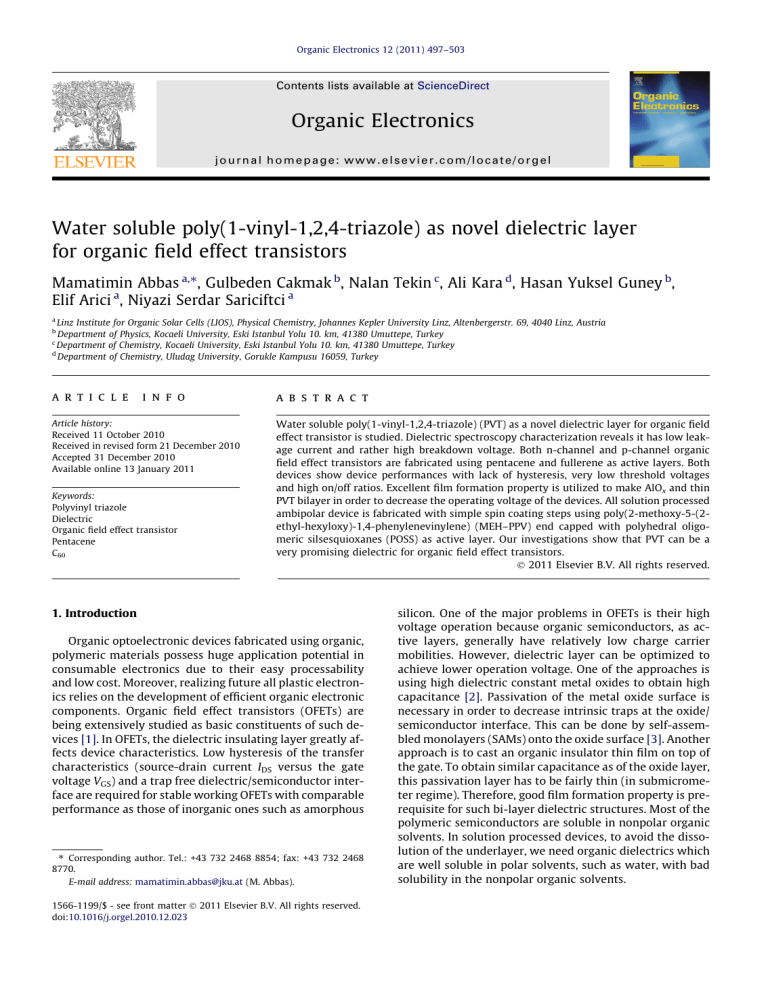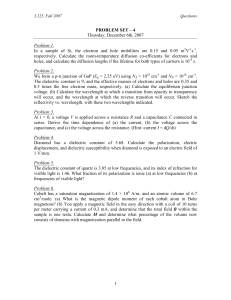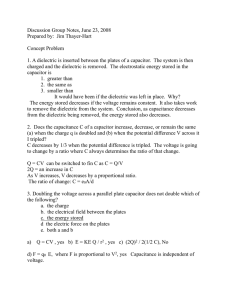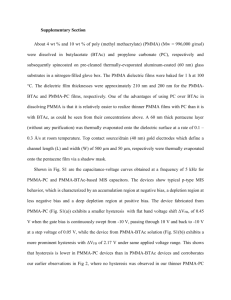
Organic Electronics 12 (2011) 497–503
Contents lists available at ScienceDirect
Organic Electronics
journal homepage: www.elsevier.com/locate/orgel
Water soluble poly(1-vinyl-1,2,4-triazole) as novel dielectric layer
for organic field effect transistors
Mamatimin Abbas a,⇑, Gulbeden Cakmak b, Nalan Tekin c, Ali Kara d, Hasan Yuksel Guney b,
Elif Arici a, Niyazi Serdar Sariciftci a
a
Linz Institute for Organic Solar Cells (LIOS), Physical Chemistry, Johannes Kepler University Linz, Altenbergerstr. 69, 4040 Linz, Austria
Department of Physics, Kocaeli University, Eski Istanbul Yolu 10. km, 41380 Umuttepe, Turkey
c
Department of Chemistry, Kocaeli University, Eski Istanbul Yolu 10. km, 41380 Umuttepe, Turkey
d
Department of Chemistry, Uludag University, Gorukle Kampusu 16059, Turkey
b
a r t i c l e
i n f o
Article history:
Received 11 October 2010
Received in revised form 21 December 2010
Accepted 31 December 2010
Available online 13 January 2011
Keywords:
Polyvinyl triazole
Dielectric
Organic field effect transistor
Pentacene
C60
a b s t r a c t
Water soluble poly(1-vinyl-1,2,4-triazole) (PVT) as a novel dielectric layer for organic field
effect transistor is studied. Dielectric spectroscopy characterization reveals it has low leakage current and rather high breakdown voltage. Both n-channel and p-channel organic
field effect transistors are fabricated using pentacene and fullerene as active layers. Both
devices show device performances with lack of hysteresis, very low threshold voltages
and high on/off ratios. Excellent film formation property is utilized to make AlOx and thin
PVT bilayer in order to decrease the operating voltage of the devices. All solution processed
ambipolar device is fabricated with simple spin coating steps using poly(2-methoxy-5-(2ethyl-hexyloxy)-1,4-phenylenevinylene) (MEH–PPV) end capped with polyhedral oligomeric silsesquioxanes (POSS) as active layer. Our investigations show that PVT can be a
very promising dielectric for organic field effect transistors.
Ó 2011 Elsevier B.V. All rights reserved.
1. Introduction
Organic optoelectronic devices fabricated using organic,
polymeric materials possess huge application potential in
consumable electronics due to their easy processability
and low cost. Moreover, realizing future all plastic electronics relies on the development of efficient organic electronic
components. Organic field effect transistors (OFETs) are
being extensively studied as basic constituents of such devices [1]. In OFETs, the dielectric insulating layer greatly affects device characteristics. Low hysteresis of the transfer
characteristics (source-drain current IDS versus the gate
voltage VGS) and a trap free dielectric/semiconductor interface are required for stable working OFETs with comparable
performance as those of inorganic ones such as amorphous
⇑ Corresponding author. Tel.: +43 732 2468 8854; fax: +43 732 2468
8770.
E-mail address: mamatimin.abbas@jku.at (M. Abbas).
1566-1199/$ - see front matter Ó 2011 Elsevier B.V. All rights reserved.
doi:10.1016/j.orgel.2010.12.023
silicon. One of the major problems in OFETs is their high
voltage operation because organic semiconductors, as active layers, generally have relatively low charge carrier
mobilities. However, dielectric layer can be optimized to
achieve lower operation voltage. One of the approaches is
using high dielectric constant metal oxides to obtain high
capacitance [2]. Passivation of the metal oxide surface is
necessary in order to decrease intrinsic traps at the oxide/
semiconductor interface. This can be done by self-assembled monolayers (SAMs) onto the oxide surface [3]. Another
approach is to cast an organic insulator thin film on top of
the gate. To obtain similar capacitance as of the oxide layer,
this passivation layer has to be fairly thin (in submicrometer regime). Therefore, good film formation property is prerequisite for such bi-layer dielectric structures. Most of the
polymeric semiconductors are soluble in nonpolar organic
solvents. In solution processed devices, to avoid the dissolution of the underlayer, we need organic dielectrics which
are well soluble in polar solvents, such as water, with bad
solubility in the nonpolar organic solvents.
498
M. Abbas et al. / Organic Electronics 12 (2011) 497–503
Poly(vinyl alcohol) (PVA) is one of the most extensively
studied water soluble polymers with high dielectric constant and excellent film formation properties [4–8]. Hysteresis had been an issue quite for a while in PVA based
OFETs [5,7,8]. Although non-volatile hysteresis behaviour
can be implemented for memory elements [5], OFETs
should have hysteresis free characteristic in logic circuit
applications. Hysteresis mechanism has been investigated
in detail and charge trapping as well as mobile ions are ascribed to be the factors [7,8]. Dialysis process can minimize
the hysteresis effects in PVA based OFETs and result in
good device characteristics for n-channel OFET devices
[8]. However, intrinsic OH groups in PVA induce potential
electron traps at the dielectric semiconductor interface
hindering n-channel electron mobility and ambipolar
behaviour of the devices [9]. Therefore, new water soluble
polymeric dielectrics need to be explored.
Poly(1-vinyl-1,2,4-triazole) (PVT) was reported to be a
non-toxic, biocompatible, thermally stable and easily soluble in water or polar organic solvents [10,11]. Monomers of
PVT were first obtained by vinylation of 1,2,4-triazole with
acetylene [12]. Later, radical polymerization was realized
[13]. Since then, PVT or copolymers have found a wide
range of applications in medicine and agriculture such as
preparation of soft contact lenses, biosynthetic activation
of connective tissue cells, clarification or stabilization of
juices and wines [14–16]. Application for nanotechnology
was proposed by incorporation of nanoparticles in the
polymer matrix [17,18]. PVT based salts are shown to be
reliable binders in propellant and explosives as energetic
polymers [19]. Recently, acid doped PVTs were studied as
promising proton conducting polymer electrolytes in proton exchange membrane fuel cells [20,21].
In his work we investigated the dielectric property of
PVT for OFETs. Dielectric spectroscopy measurements show
low leakage current and very high breakdown voltage
(around 4 MV cm1). Excellent film formation and smooth
surfaces of the PVT films are observed by using atomic force
microscopy. We used pentacene as p-channel and C60 as nchannel semiconductor layers. Both types of devices based
on PVT revealed hysteresis free transfer characteristics with
relatively high on/off ratios (>1000) and low threshold voltages. Solution processed ambipolar OFET device was realized using simple spin coating steps. All these technical
properties suggest PVT as an excellent polymer dielectric
for OFETs.
Device preparation: PVT was dissolved in high resistant ultra-pure water in a weight ratio of 7%. The solution was filtered and spin-coated on glass substrate with evaporated
Al gate contact. The films were dried in vacuum oven overnight at a temperature of 50 °C. For AlOx/PVT bi-layer
dielectric, Al gate contacts were partially anodized as described in references [24,25]. In ultra-pure water and citric
acid solution (0.01 M), constant current density of
6 mA cm2 was applied between Al contact and stainless
steel counter electrode. Final anodization voltage was set
to 50 V with anodization ratio around 1.3 nm V1, which
2. Experimental
2.1. Materials
Vinyl-triazole monomer was bought from Sigma–Aldrich and polymerized using Free radical polymerization
technique. Azobisisobutyronitrile was used as radical initiator, benzene as solvent and CCl4 as chain transfer agent.
Pentacene (normal grade, carbon P93.5%) and C60 (sublimation grade, 99.9%) were purchased from Sigma–Aldrich
and MER corporation, respectively. They were used as received. MEH–PPV–POSS was purchased from American
Dye Source Inc. It was purified by repeated precipitation.
Fig. 1. (a) Molecular structure of poly(1-vinyl-1,2,4-triazole) (PVT),
fullerene (C60), pentacene and MEH–PPV–POSS; (b) Device structure of
the bottom gate, top contact OFETs structure used. Al gate contact was
partially anodized to make AlOx layer for low voltage operation devices.
Pentacene as p-channel semi-conducting layer has Au source/drain
contacts, whereas C60 as n-channel semi-conducting layer has LiF/Al
source/drain contacts. Channel length is 0.06 mm, and channel width is
2 mm. For ambipolar OFET with MEH–PPV–POSS as active layer, Ca/Au
asymmetric contacts were angle evaporated. Channel length is 0.05 mm
and channel width is 3 mm.
M. Abbas et al. / Organic Electronics 12 (2011) 497–503
gives around 65 nm thickness of AlOx layers. They were
dried in vacuum oven at 120 °C overnight. On top of it,
low concentration PVT solution (1.5% weight ratio) was
spin-coated (1500 rpm for 40 s). The films were dried in
vacuum oven overnight at a temperature of 50 °C. For
dielectric characterization, Al contact was evaporated
through shadow mask to make MIM structure. Electrode
contact area is 4.84 mm2. Two different thickness films
were spin coated using 2000 rpm and 3000 rpm for 30 s,
and thicknesses were measured using AFM. For OFETs, 7%
weight ratio PVT solution was spin coated (1500 rpm for
40 s and 2000 rpm for 20 s) on glass substrate with evaporated Al gate contact. Pentance (100 nm) and C60 (100 nm)
films were thermally evaporated in UNIVEX system. Substrate was kept at room temperature. Evaporation rate is
around 0.5 nm s1. Au (100 nm) for pentance films and
LiF(0.6 nm)/Al(100 nm) for C60 films as sources/drain contacts were evaporated thermally through shadow mask
to complete the bottom gate, top contact OFET devices.
Channel length is 0.06 mm and channel width is 2.0 mm.
MEH–PPV–POSS was dissolved in Cholorobenzene (15
mg/ml) and spin coated (1500 rpm for 40 s and 2000 rpm
for 20 s) directly on top of PVT. Ca (50 nm) and Au
(50 nm) asymmetric contacts were angle evaporated using
thick shadow mask. Channel length is 0.05 mm and channel width is 3.0 mm. Characterization: PVT film morphol-
499
ogy and thickness are investigated with Atomic Force
Microscopy (Digital Instruments Dimension 3100) in tapping mode. Images are analysed using WSxM software
[26]. For MIM structures, dielectric spectroscopy was
obtained with a Novocontrol Alpha Analyzer. Leakage DC
current was measured using Keithley 230 unit. I–V characterizations were performed using Agilent E5273A. All the
characterizations were carried out in nitrogen glove box
or sealed box with nitrogen gas.
3. Results and discussions
Chemical structure of PVT is given in Fig. 1a). Electron
rich nitrogen atoms in triazole ring can form hydrogen
bonds with water molecules, which is an exothermic dissolution process.
Spin coating of PVT films results in very homogeneous
film. AFM images of the films with 720 nm and 960 nm
thicknesses are shown in Fig. 2a and b. Both give very
low root-mean-square roughness of about 0.2 nm. We
have made metal–insulator–metal (MIM) structure of
PVT films sandwiched between evaporated Al electrodes
for dielectric characterization, results of which are shown
in Fig. 3. The contact area is 4.84 mm2, and film thicknesses
are 720 nm and 960 nm as measured by AFM. Frequency
dependence of the capacitance is given in Fig. 3a. From
Fig. 2. AFM images of spin coated PVT films on Al gate with glass substrate: (a) 720 nm; (b) 960 nm; (c) 90 nm; (d) 90 nm film on anodized AlOx surface.
500
M. Abbas et al. / Organic Electronics 12 (2011) 497–503
tance values at 10 Hz is used to determine the dielectric
constant k, as given by C i ¼ e0 k=d, where Ci represents
capacitance per unit area and d is the thickness of the
dielectric layer. Linear fitting of the capacitance values versus different thicknesses yields dielectric constant of 5.1.
Low leakage current is necessary to achieve high on/off ratio from an OFET. Leakage current versus applied electric
field is shown in Fig. 3b. DC voltage is applied within
±110 V. At an electric field of 1 MV cm1, we have observed
a leakage current density of around 5 108 A cm2.
Dielectric strength of an insulator can be represented by
the breakdown electric field, i.e. the sustainable voltage
maximum before it loses its insulating character. It’s a crucial parameter in achieving high capacitance by decreasing
the thickness of the dielectric. Breakdown electric field of
PVT is higher than 4 MV cm1 as shown in Fig. 3c for the
720 nm thick sample, where capacitance were measured
by ramping up the applied voltage at a frequency of 10 Hz.
Fig. 4a shows typical transfer characteristics of PVT in a
p-channel device with pentacene as active layer. Gate leakage current is about 0.2 nA at 15 V. No hysteresis is observed with forward and reverse gate voltage sweep for the
transfer curve. In the gradual channel approximation, drain
current dependence on the gate voltage can be given by the
following equation in saturation regime (given mobility is
independent of the gate voltage):
IDS ¼ ðW=2LÞlsat C i ðV GS V th Þ2
where IDS is the drain current; lsat is the mobility; VGS is
the gate voltage; Vth is the threshold voltage; W is the
channel width and L is the channel length. The square root
of drain current versus gate voltage of the saturation curve
can be linearly extended to the ‘‘off’’ current to determine
the threshold voltage. Rather low threshold voltage of
2.2 V is obtained. Considering the flat band potential of
Al gate and pentacene work function, and also quite low
dielectric capacitance of around 5 nF cm2, this value implies very low trap density. We have estimated the total
trap density of 2.3 1010 cm2 using N trap ¼ C i jV th V to j=e, where Ci is the capacitance per unit area; Vth is
threshold voltage as determined above; Vto is the turn-on
voltage which refers to applied gate voltage at the onset
of the drain current [22]. Sub-threshold swing of
1.75 V dec1 is derived. It reflects ‘‘turning on’’ speed of
the device and correlates to the interface trap capacitance
Cit through the equation [2]: S ¼ ðK B T=eÞ lnð10Þð1 þ C it =C i Þ.
On/off ratio is higher than 103. The device sustained
200 V gate voltage without breakdown and further scaled
up on/off ratio. Good linear and saturation behaviour is observable from the output curves (Fig. 4b). Mobility can be
estimated from the linear regime where the charge carriers
are uniformly distributed as given in the equation below:
IDS ¼ W=Lllin C i ðV GS V th ÞV DS
Fig. 3. Dielectric characterization of PVT films (720 nm and 960 nm) as in
Al/PVT/Al structure: (a) frequency dependence of the capacitance; (b)
leakage current versus applied DC voltage; (c) capacitance versus applied
electric field at 10 Hz for the sample with the thickness of 720 nm.
0.01 Hz to 10 kHz, the capacitances of the films show
dispersionless behaviour with rather low variance. Capaci-
where VDS is the drain voltage. Calculated hole mobility is
0.002 cm2 V1 s1. Dielectrics are more critical for the performance of n-channel OFETs, as the hydroxyl groups in organic dielectrics tend to trap electrons easily. However, it is
essential for the dielectric to perform in an equal manner
for both p- and n-channel devices if ambipolar and light
M. Abbas et al. / Organic Electronics 12 (2011) 497–503
501
Fig. 5. Transfer (a) and output (b) characteristics of fullerene as nchannel OFET device with PVT dielectric layer. LiF/Al source/drain
contacts were used with channel length of 0.06 mm and channel width
of 2 mm.
Fig. 4. Transfer (a) and output (b) characteristics of pentacene as pchannel OFET device with PVT dielectric layer. Au source/drain contacts
were used with channel length of 0.06 mm and channel width of 2 mm.
emitting OFETs are pursued for various purposes. We
investigated PVT in n-channel OFET, where C60 is used as
active layer. Fig. 5a shows typical transfer characteristics
of such an OFET device. Transfer curve again shows almost
hysteresis free behaviour with forward and reverse gate
voltage sweep. Slightly higher off currents can be due to
the higher conductivity of C60 at drain voltage of 15 V as
compared to the pentacene device. On/off ratio is higher
than 103 and further scaling up is possible without breaking the dielectric. Gate leakage current is about 0.9 nA at
15 V. Derived threshold voltage is around 5.5 V. Comparing
to p-channel OFET, this value suggests total trap states for
electrons are slightly higher. Estimated total trap density
from the difference between threshold voltage and turnon voltage is about 6.6 1010 cm2. Compared to the C60
n-channel OFET based on dialysis grade PVA [8], using
PVT as dielectric gives superior parameters. Sub-threshold
swing is about 3.2 V dec1. Again, clear linear and saturation behaviour is observable from the output curves
(Fig. 5b). Estimated electron mobility from the linear regime is 0.02 cm2 V1 s1.
Low voltage operation of OFETs is required for their
practical application. Increasing capacitance of the dielectric layer is a direct approach. By decreasing the thickness
of the film, one can obtain higher capacitance, thus lower
operating voltage. Main problems can be that polymer
dielectrics may not form homogenous films when solution
concentration is lowered; leakage current may be comparable to the drain current or it can be easily breakdown.
Cross linking of the thin polymer dielectrics is a viable approach. However, it will introduce additional processing
step and impurities left from the cross linking agents might
affect the performance of the devices. AFM study evidenced very good film formation property of PVT. When
thinner films are prepared with low solution concentration, PVT still forms homogeneous films without defects
or pinholes (see Fig. 2c). We attempted to fabricate n-channel OFET devices with dielectric thickness as low as 90 nm
(capacitance around 50 nF cm2). Among more than 16 devices, almost all the devices worked below 1 V, with two
orders of magnitude on/off ratio and well defined linearsaturation behaviours. Despite such a high yield, when
gate voltage is applied more than 1 V to achieve comparable on/off ratios, leakage current becomes higher than
those of the devices with thick PVT layer. In order to realize
similar performance as of the thick PVT films, we fabri-
502
M. Abbas et al. / Organic Electronics 12 (2011) 497–503
cated anodized AlOx/PVT bi-layer dielectric to control the
leakage current. Sixty-five nanometer AlOx with capacitance around 120 nF cm2 and 90 nm PVT with capacitance of 50 nF cm2 yields a total capacitance of
35 nF cm2. Roughness of the film increased slightly due
to the anodized AlOx layer (see Fig. 2d) with root-meansquare roughness of about 1 nm. Fig. 6a shows the transfer
characteristic of pentacene p-channel OFET based on such
a bi-layer dielectric. At applied voltage of 3 V, the device
performed in similar fashion as the thick PVT film based
device. Gate leakage current is 0.4 nA at gate voltage of
3 V. Threshold voltage is about 1.5 V. Sub-threshold
swing of 360 mV dec1 is comparable to state of art low
voltage operation OFET devices and direct result of low
interface trap states. Linear and saturation trends in the
output curves are evident (Fig. 6b). More impressive performance is attained in the C60 n-channel devices. Fig. 7a
shows typical transfer curve. At applied voltage of 2 V,
the device performed in a similar way as the thick PVT film
based device with comparable on/off drain current ratio.
Gate leakage current is 0.6 nA at gate voltage of 2 V.
Threshold voltage is about 0.6 V and sub-threshold swing
shows a very low value of 230 mV dec1. Output curves
are shown in Fig. 7b.
Fig. 7. Transfer (a) and output (b) characteristics of fullerene as nchannel OFET device with AlOx (65 nm) and PVT (90 nm) dielectric bilayer. LiF/Al source/drain contacts were used with channel length of
0.06 mm and channel width of 2 mm.
Fig. 6. Transfer (a) and output (b) characteristics of pentacene as pchannel OFET device with AlOx (65 nm) and PVT (90 nm) dielectric bilayer. Au source/drain contacts were used with channel length of
0.06 mm and channel width of 2 mm.
For all solution processed device, PVT, as a water soluble polymer dielectric, is suitable for most of the organic
semiconductors. Here we used poly(2-methoxy-5-(2-ethylhexyloxy)-1,4-phenylenevinylene) (MEH–PPV) end capped
with polyhedral oligomeric silsesquioxanes (POSS) as the
active layer. Although its lower charge carrier mobility
has not been appreciated for organic transistors, comparatively high photoluminescence efficiency is very promising
for efficient light emission from organic transistor device.
POSS renders relatively high air stability for the polymer
without changing its absorption and photoluminescence
[23]. MEH–PPV–POSS was directly spin coated on top of
the PVT dielectric. Ca and Au source/drain electrodes were
angle evaporated for efficient electron and hole injection.
Typical transfer characteristics of such an ambipolar OFET
device are shown in Fig. 8a. Both electron and hole
enhancement is observed. This can also be confirmed by
the output curves as displayed in Fig. 8b, where pronounced increase of drain current can be observed at low
or reverse gate bias, a typical ambipolar current behaviour.
M. Abbas et al. / Organic Electronics 12 (2011) 497–503
503
lar and light emitting OFETs. Moreover, its solubility in
water allows for a wide range of solution processed polymer based OFET devices directly fabricating layer by layer.
Biocompatibility of PVT is another advantage of its application for bio-electronic devices.
Acknowledgements
We are grateful for the useful discussions with Dr.
Martin Egginger and Dr. A. Montaigne Ramil. The work is
financially supported by FWF project of AMBIPOL (No.
P20724-N20).
References
Fig. 8. Transfer (a) and output (b) characteristics of ambipolar OFET
device with MEH–PPV–POSS active layer and PVT dielectric layer. Ca/Au
asymmetric source/drain contacts were angle evaporated. Channel length
is 0.05 mm and channel width is 3 mm.
4. Conclusions
In summery, we have investigated the dielectric property of PVT and its application for OFETs. PVT films showed
considerably high breakdown voltage and low leakage
current. Both n-channel and p-channel OFET devices are
fabricated. Excellent performances are observed in both
devices, with hysteresis free and very low threshold voltages. Owing to its good film formation property, using
anodized AlOx/PVT bi-layer dielectrics, both p-channel
and n-channel OFET devices operated in low voltages with
low threshold voltage and sub-threshold swing. Solution
processed ambipolar device is fabricated with simple spin
coating steps. Typical ambipolar characteristics were observed. Our results show that PVT can be a very promising
polymer dielectric for OFET devices, especially for ambipo-
[1] J. Zaumseil, H. Sirringhaus, Chem. Rev. 107 (2007) 1296.
[2] R.P. Ortiz, A. Facchetti, T.J. Marks, Chem. Rev. 110 (2010) 205.
[3] L.-L. Chua, J. Zaumseil, J.-F. Chang, E.C.-W. Ou, P.K.-H. Ho, H.
Sirringhaus, R.H. Friend, Nature 434 (2005) 194.
[4] R. Parashkov, E. Becker, G. Ginev, T. Riedl, H.-H. Johannes, W.
Kowalsky, J. Appl. Phys. 95 (2004) 1594.
[5] Th.B. Singh, N. Marjanovic, G.J. Matt, N.S. Sariciftci, R. Schwödiauer, S.
Bauer, Appl. Phys. Lett. 85 (2004) 5409.
[6] T.B. Singh, F. Meghdadi, S. Gunes, N. Marjanovic, G. Horowitz, P. Lang,
S. Bauer, N.S. Sariciftci, Adv. Mater. 17 (2005) 2315.
[7] C.A. Lee, D.W. Park, S.H. Jin, H. Park, J.D. Lee, B.-G. Park, Appl. Phys.
Lett. 88 (2006) 252102.
[8] M. Egginger, M. Irimia-Vladu, R. Schwodiauer, A. Tanda, I. Frischauf,
S. Bauer, N.S. Sariciftci, Adv. Mater. 20 (2008) 1018.
[9] M.-H. Yoon, C. Kim, A. Facchetti, T.J. Marks, J. Am. Chem. Soc. 128
(2006) 12851.
[10] Yu.S. Bulyshev, I.M. Kashirskii, V.V. Sinitskii, G.F. Myatchina, T.G.
Ermakova, V.A. Lopyrev, Phys. Stat. Sol. (A) 70 (1982) 139.
[11] M.V. Kurik, G.F. Myachina, T.G. Ermakova, Mol. Cryst. Liq. Cryst. 468
(2007) 669.
[12] L.P. Makhno, T.G. Ermakova, E.S. Dommina, L.A. Tatarova, G.G.
Skvortsov, V.A. Lopyrev, USSR Inventor’s Certificate 1975, No.
464584, Byull. Izobret., No. 11.
[13] L.A. Tatarova, T.G. Yermakova, A.A. Berlin, Y.F. Razvodovskii, L.A.
Lopyrev, N.F. Kedrina, N.S. Yenikopolopyan, Vysokomol. Soedin. Ser.
A 24 (1982) 2205.
[14] T.G. Ermakova, N.P. Kuznetsova, Nauka-Proizvod.-Stvu. 6 (2003) 55.
[15] L.A. Mansurova, A.B. Skornyakova, N.A. Sevastyanova, L.A. Tatarova,
T.G. Ermakova, V.A. Lopyrev, V.B. Kazimirovskaya, L.I. Slutskii,
Khim.-Farm Zh. 25 (1991) 22.
[16] V.I. Zinchenko, A.S. Makarov, V.A. Lopyrev, T.G. Ermakaova, L.A.
Tatarova, Pivo Napitki 4 (1999) 58.
[17] G.F. Myachina, S.A. Korzhova, T.G. Ermakova, B.G. Sukhov, B.A.
Trofimov, Doklady Chem. 420 (2008) 123.
[18] G.F. Myachina, T.V. Konkova, S.A. Korzhova, T.G. Ermakova, A.S.
Pozdnyakov, B.G. Sukhov, K.Yu. Arsentev, E.V. Likhoshvai, B.A.
Trofimov, Doklady Chem. 431 (2010) 63.
[19] H. Xue, H.X. Gao, J.M. Shreeve, J. Polym. Sci. Part A-Polym. Chem. 46
(2008) 2414.
[20] S.U. Celik, A. Aslan, A. Bozkurt, Solid State Ionics 179 (2008) 683.
[21] A. Aslan, S.U. Celik, U. Sen, R. Haser, A. Bozkurt, Electrochim. Acta 54
(2009) 2957.
[22] K.P. Pernstich, S. Haas, D. Oberhoff, C. Goldmann, D.J. Gundlach, B.
Batlogg, A.N. Rashid, G. Schitter, J. Appl. Phys. 96 (2004) 6431.
[23] S. Xiao, M. Nguyen, X. Gong, Y. Cao, H. Wu, D. Moses, A. Heeger, Adv.
Funct. Mater. 13 (2003) 25.
[24] L.A. Majewski, M. Grell, S.D. Ogier, J. Veres, Org. Elect. 4 (2003) 27.
[25] L.A. Majewski, R. Schroeder, M. Grell, Adv. Mater. 17 (2005) 192.
[26] I. Horcas, R. Fernandez, J.M. Gomez-Rodriguez, J. Colchero, J. GomezHerrero, A.M. Baro, Rev. Sci. Instrum. 78 (2007) 013705.






